ISSN ONLINE(2319-8753)PRINT(2347-6710)
ISSN ONLINE(2319-8753)PRINT(2347-6710)
S.BalaKumar 1, B.Baskaran 2
|
| Related article at Pubmed, Scholar Google |
Visit for more related articles at International Journal of Innovative Research in Science, Engineering and Technology
This work proposes EZ – inverter for AC-AC conversion in hybrid wind –solar generation system. This paper presents modeling and simulation of EZ-source based AC to AC converter system. The PV cell acts as one of the DC sources required by the EZ circuit. The other DC source is obtained by using wind generator and rectifier. The output of EZ network is applied to the three phase inverter which feeds an induction motor load. The simulation studies are performed using matlab and the results are presented.
Keywords |
| EZ-Source Network, AC-AC converter, Wind Energy Conversion System (WECS), MATLAB, PV cells. |
INTRODUCTION |
| Wind is one of the richest renewable source of energy in natural history. The economical and environmental advantages offered by wind energy are the most key reasons why electrical systems based on wind energy are receiving vast global attention. Due to the increasing demand on electrical energy, a significant amount of effort is being made to generate electricity from harmless renewable energies. Renewable energy sources presently provide 15% of the world energy demand. A 30% of power generation contribution from renewable energy sources by year 2020 is proposed in [1]. |
| These energy sources hold promise and are projected to become increasingly important in the future. Among the popular renewable energy systems are Wind Energy Conversion Systems (WECS), Photovoltaic Energy Systems (PVES) and Fuel Cell Systems (FCS). It has been proven that small-to-medium size (10-100KW) hybrid generation systems based on wind and solar sources may meet the electricity requirements of lamps and small appliances, and rural industries, community centers, health clinics, and school [2].There are a number of wind turbine technologies, and they have different capabilities and effects with respect to these power systems issues. In light of such issues, wind turbine configurations and farm models are being more carefully examined to determine their potential and limitations [3]. |
| Commercial wind turbine technology has so far been designed to maximum energy production. In the future, operators may need to trade off efficiency of operation with flexibilities of operation. It has become important to understand and quantify the capabilities of wind energy conversion systems to optimize their interaction with the grid, as opposed to optimizing energy efficiency [4]. Traditionally, there are two types of inverters used; commonly known as Voltage Source Inverter (VSI) and Current Source Inverter (CSI). Both of these inverters have limited operating range even though both are used in DF applications [5]. The above literature does not deal with EZ-Source inverter based AC to AC converter for wind generation. This work proposes EZSI based AC to AC converter for wind conversion system. The energy sources like wind and solar radiation are transformed in a wind generator and PV modules. In order to combine these energy sources, a multiple input DC-DC converter is used because it is more effective for maximum power point Tracking (MPPT) in PV and also used for the input current control method [6]. It is capable of converting power from multiple power sources to a common load. The MIC is often selected due to its reduced component count and cost of the system. In the nineties, Fang, Zhang and Peng have popularized the concept of the ZSI [7]. For controlling the Z-source inverter, many pulse width modulation schemes [8] have also been reported with some achieving a lower switching loss and others realizing an optimized harmonic performance. The block diagram of wind energy conversion system is shown in Fig 1. The output of wind generator is rectified and filtered using a EZ-network. The inverter converts DC into fixed frequency AC and it feeds an induction motor load. |
 |
II. EZ-SOURCE NETWORK |
| The voltage –type EZ-source inverter shown in Fig( 2) has its DC sources embedded within the x- shaped LC impedance network with its inductive elements L1 and L2 now respectively, used for filtering the currents drawn from the two dc sources without using any external LC filter[10]. The current is drawn from the two DC sources . Though the arrangement can occasionally interpret to a slightly higher cost, but the advantages exhibited by the EZ source inverter outweigh the serious limitations. The advantages are more clearly illustrated by analyzing the inverter operating principle. Based on switching states of the inverter, the EZSI can be classified into three modes. |
| Mode 1: Inverter bridge is operating in one of the six active states. In this mode, the front end diode D is forward biased and the inverter bridge and external load is replaced by a current source. The capacitor is charged and energy flows to the load through the inductor. |
| Mode 2: Inverter bridge is operating in any one of the two zero states as the inverter short circuits the load through either upper or lower three switching devices. The bridge can be viewed as an open circuit. The voltage of DC source appears across the inductor and capacitor but no current flows to the load from DC source. |
| Mode 3: The Inverter is in one of the seven different ways of shoot through. In this mode the inverter bridge is shorted through and the diode D is reverse biased. In this mode no voltage appears across the load like in zero state operation, to required value based on shoot through duty ratio. |
| Analysis clearly shows that EZ source inverter system produces same transfer gain as Z-source inverter system even though EZSI has two DC sources embedded within the impedance network for achieving source filtering. Also the capacitor voltage is greatly reduced when compared to Z-source inverter inferring that there is significant reduction of capacitor voltage rating [11]. |
 |
III. DESIGN OF EZ-SOURCE NETWORK |
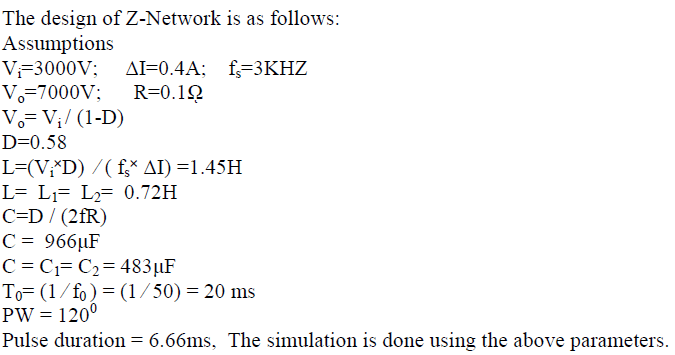 |
IV. SIMULATION RESULTS |
| EZSI based AC to AC converter for hybrid wind-solar generation is modeled using the elements of Simulink and results are presented here. The AC to AC converter circuit with R-load is shown in Fig 3a. Solar cell acts as one DC source. The wind generator with an uncontrolled rectifier acts as the other DC source. Power measurement of the solar system is shown in Fig 3b. The output voltage of solar system is shown in Fig 3c. The output voltage is around 50V. The measurement block of wind system is shown in Fig 3d. The output voltage of wind generator is shown in Fig 3e. The output of EZ-Source is shown in Fig 3f. The pulses used for switching the inverter are shown in fig 3g. The line to line voltages are shown in Fig 3h. The three phase output currents are shown in Fig 3i. |
| Simulink model of hybrid wind –solar system fed induction motor system is shown in Fig 4a. Solar cell acts as one DC source. The wind generator with an uncontrolled rectifier acts as the other DC source. Power measurement of the solar system is shown in Fig 4b. The output voltage of solar system is shown in Fig 4c. The output voltage is around 50V. The measurement block of wind system is shown in Fig 4d. The output voltage of wind generator is shown in Fig 4e. The output of EZ-Source is shown in Fig 4f. The pulses used for switching the inverter are shown in Fig 4g. The line to line voltages are shown in Fig 4h. The three phase output currents are shown in Fig 4i. The speed response curve is shown in Fig 4j. The speed increases and the speed settles at 1480 RPM. The torque increases and settles at 25N-m. |
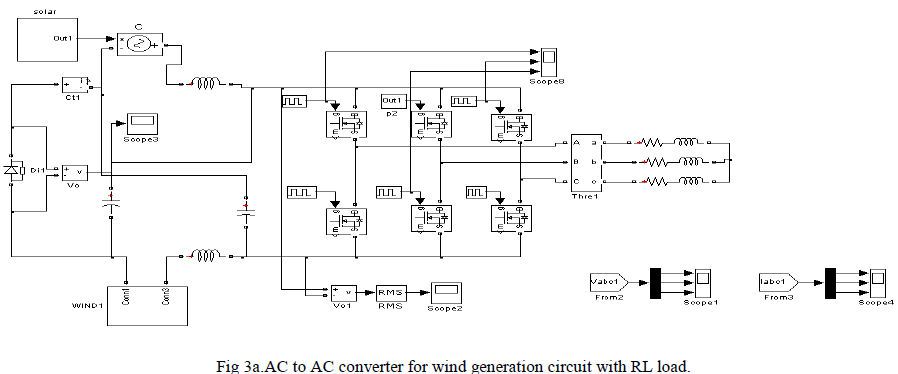 |
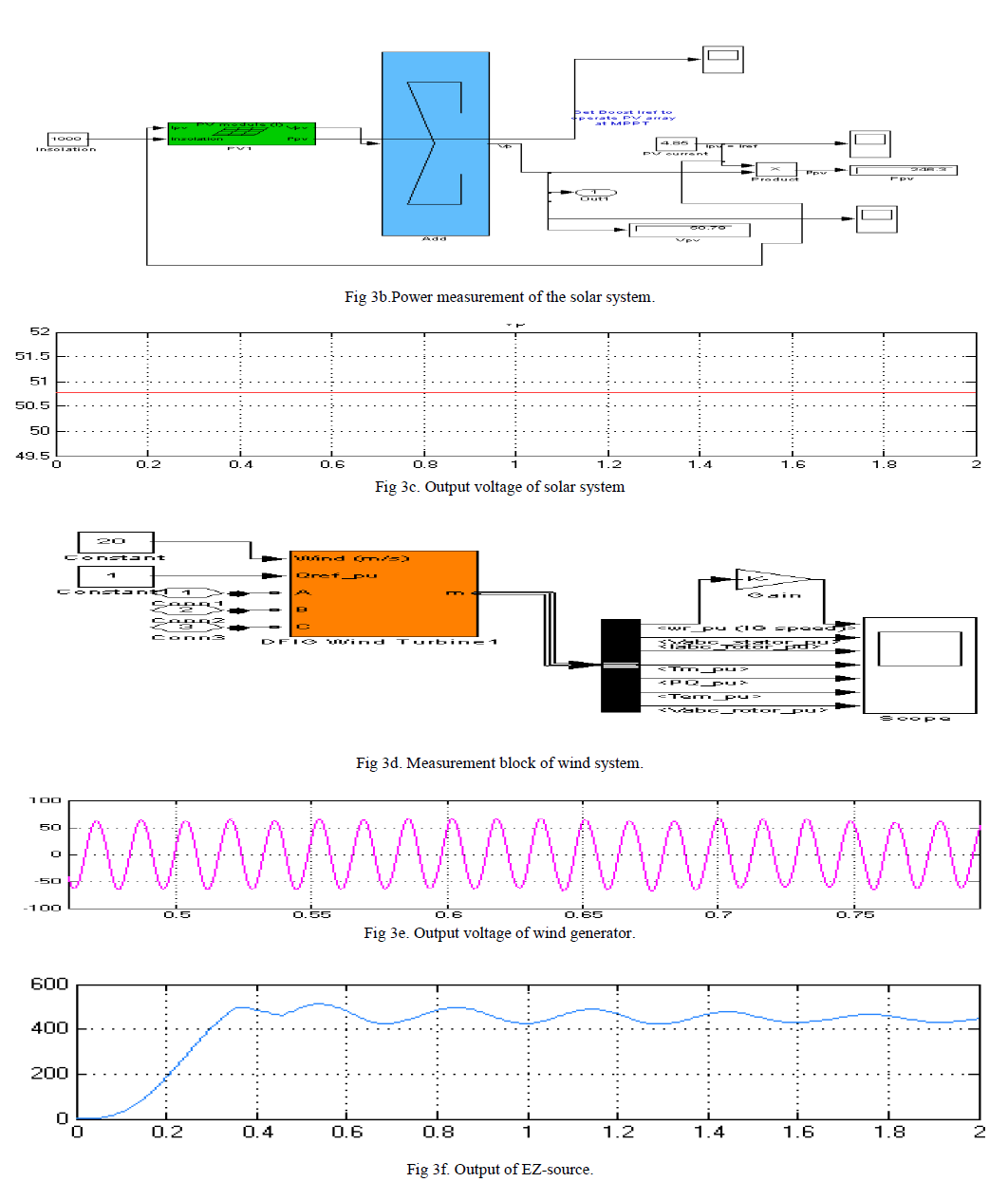 |
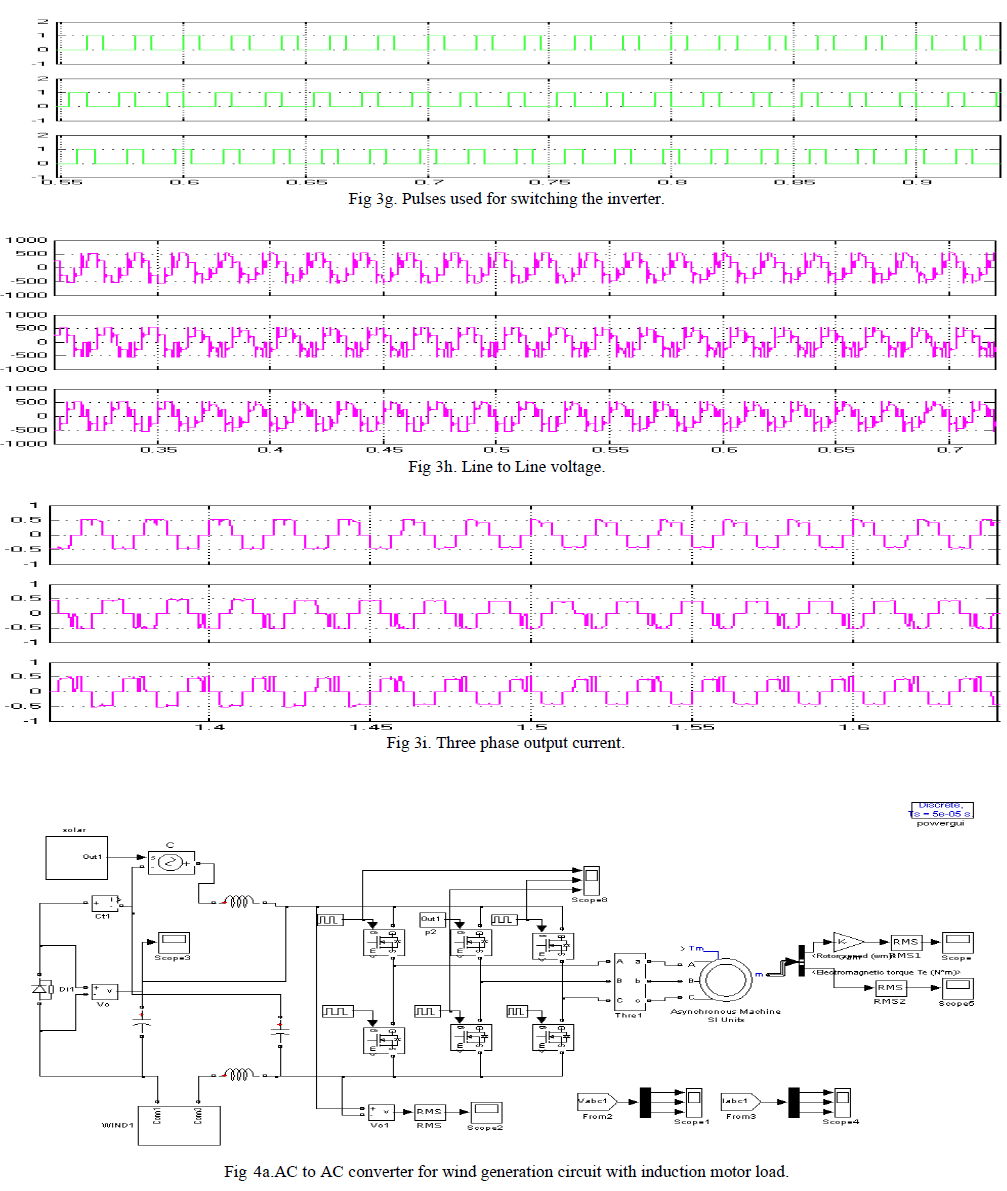 |
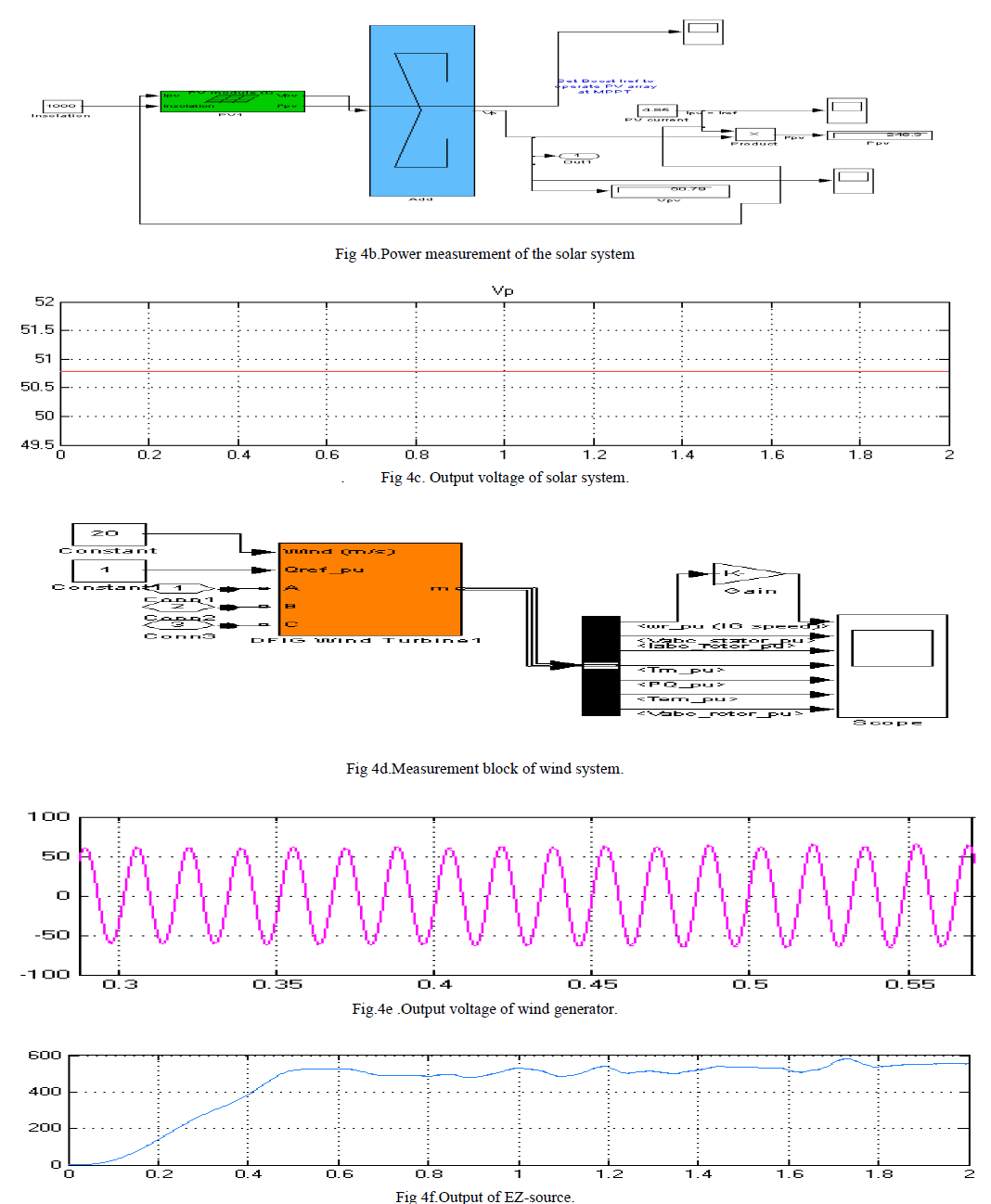 |
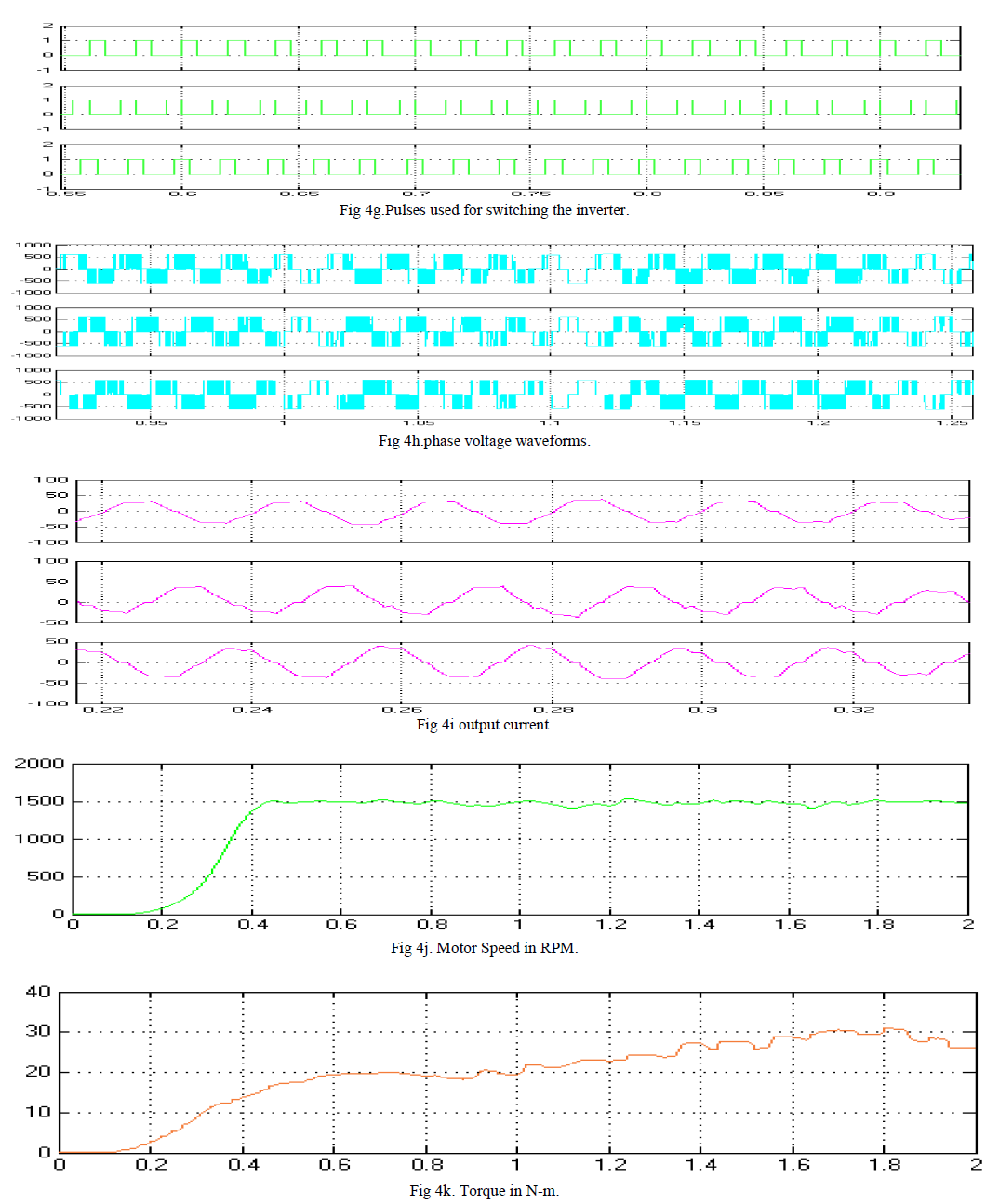 |
V. CONCLUSION |
| EZSI based AC to AC converter for hybrid wind-solar energy conversion is successfully designed, modeled and simulated. EZ network is capable of boosting low voltage to the required level. The voltage ripple in the output of the rectifier is reduced by using EZ network. Thus the EZSI based AC to AC converter system improves the power quality at the output. The simulation results are in line with the predictions. |
| The scope of the work is the design and the simulation of EZSI based AC to AC converter system. The PIC based hardware implementation will be done in future. This system has advantages like reduce ripple, reduce THD and boosting capability. The disadvantages of this system is that it requires two sources of equal voltage rating. |
References |
|